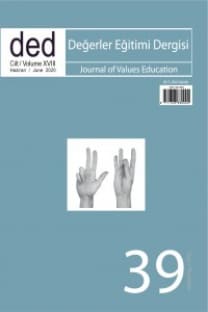Mezun Oldukları Liselere Göre Üniversite Öğrencilerinin Dindarlık Düzeyleri, Diyanet İşleri Başkanlığı Hizmetlerine ve Dinî Gruplara Yönelim Durumları
Bu makalede, üniversite öğrencilerinin mezun oldukları liselere göre dindarlık seviyeleri, Diyanet İşleri Başkanlığı (DİB) hizmetlerine ve dinî gruplara yönelim düzeyleri belirlenmiştir. Araştırmada ayrıca, dindarlık seviyeleri, Diyanet İşleri Başkanlığı hizmetlerine ve dinî gruplara yönelim düzeyleri arasındaki ilişki ele alınmıştır. Araştırma, Ankara ve Erciyes üniversitelerine bağlı 23 fakülte ve yüksek okuldan, 1149 öğrencinin katılımıyla gerçekleştirilmiştir. Analizlerden elde edilen sonuçlar, İmam Hatip Lisesinden gelen öğrencilerin dinî yönelimleri ile dinî grup yönelimlerinin yüksek; Özel Liselerden gelen öğrencilerin de dindarlık puanlarının, Diyanet ve dinî grup yönelimlerinin düşük olduğunu göstermektedir. Ayrıca, dindarlık puanları ile DİB, DİB'na duyulan ihtiyaç ve dinî gruplara yönelim arasında pozitif ve anlamlı; dindarlık ile din işlerinin dinî gruplara bırakılması arasında ise negatif ve anlamlı bir ilişki bulunmuştur.
Anahtar Kelimeler:
Dinî Yönelim, Dindarlık, Diyanet, Diyanet İşleri Başkanlığına Yönelim, Dinî Gruplara Yönelim
Religiosity and Orientations Towards the Diyanet and Religious Groups: With Reference to University Students on the Basis of Educational Backgrounds
This paper investigated university students’ religious attitudes and
orientations towards Diyanet and religious groups on the basis of educational
backgrounds. It also seeks associations between religious attitudes and orientations
towards Diyanet and religious groups. Measurement instruments of this
survey were carried out among 1149 students in twenty-three academic departments
in the University of Ankara and the University of Erciyes. Considering educational
backgrounds, students who attended Imam Hatip Lise were the most religious
and religious group oriented compared with those who attended other lises.
Students who attended private lise tended to be the least religious, and the least
Diyanet and religious group oriented. A positive significant relationship between
the religiosity of university students and Diyanet, “need for Diyanet” and religious
groups orientations was found. However, a negative significant association between
the university students’ religiosity and a statement that “All religious affairs
should be regulated by religious groups” was found.
Keywords:
Religious Attitudes, Religiosity, Orientation towards the Diyanet and Orientation towards Religious Groups.,
___
Back, C. W. & Bourque, L. B. (1970). Can feelings be enumerated? Behovioral Science, 15, 487-496.Berkes, N. (1998). The development of secularism in Turkey. London: Hurst and Company.
Bolay, S. H. & Türköne, M. (1995). Din eğitimi raporu. Ankara: Ankara Merkez imam Hatip Lisesi Öğrencileri ve Mezunları Vakfı.
Bulut, M. (1994). Kuruluş yıllarında diyanet işleri başkanlığı ve din hizmetleri (Kuruluşunun 70. yılı münasebetiyle). Diyanet ilmi Dergi, 30 (4), 99-128.
Demirci, E. (1996). Modernisation, religion and politics in Turkey: The case of the iskenderpasa community. Unpublished doctoral dissertation, The Faculty of Economic and Social Studies, The University of Manchester. Manchester, UK.
DiB. (2000). T. C. Başbakanlık Diyanet işleri Başkanlığı: Özet Bilgiler. Ankara: Dini Yayınlar Dairesi Başkanlığı.
Ekşi, H. (2002). Din eğitimi, gençlik ve kişilik: imam Hatip Lisesi öğrencileri üzerine bir araştırma. H. Hökelekli (Ed.), Gençlik, din ve değerler psikolojisi içinde (s. 153-182). Ankara: Ankara Okulu Yayınları.
Erickson, J. A. (1992). Adolescent religious development and commitment: A structural equation model of the family, peer group, and educational influences. Journal for the Scientific Study of Religion , 31, 131-152.
Fırat, E. (1977). Üniversite öğrencilerinde Allah inancı ve din duygusu: Din psikolojisi açısından bir değerlendirme. Yayımlanmamış doktora tezi, Ankara Üniversitesi ilahiyat Fakültesi, Ankara.
Francis, L. J., & Stubbs, M. T. (1987). Measuring attitudes towards Christianity: From childhood to adulthood. Personality and Individual Differences, 8, 741-743.
Fulton, A. S. (1996). Identity status, religious orientation, and prejudice. Journal of Youth and Adolescence, 26 (1), 1-11.
Gilliat-Ray, S. (1999). Higher education and student religious identity. Exeter: University of Exeter in association with the Inter Faith Network for the UK.
Hay, D. (1990). Religious experience today. London: Mowbray.
Johnstone, R. (1966). The effectiveness of Lutheran elementary and secondary schools as agencies of Christian education. St Louis, MO: Concordia Seminary.
Kaymakcan, R. (1996). Religious education in the multi-party period in Turkey. East/West Education, 1-2, 91-107.
Koştaş, M. (1995). Üniversite öğrencilerinde dine bakış. Ankara: Türkiye Diyanet Vakfı Yayınları.
Murphy, K. R. & Davidshofer, C. O. (1994). Psychological testing: Principles and applications. New Jersey: Prentice-Hall.
Mutlu, K. (1996). Examining religious beliefs among university students in Ankara. British Journal of Sociology, 47 (2), 353-359.
Myers, D. G. (1999). Social psychology. Boston: McGraw-Hill College.
Norusis, M. J. (1999). SPSS 9.0 guide to data analysis. New Jersey: Prentice Hall.
Onay, A. (2000). Religious attitudes and Muslim identity, with reference to Turkish university students. Unpublished doctoral dissertation, Department of Theology and Religious Studies, University of Leeds, Leeds, UK.
Osgood, C. E., Suci, G. J., & Tannenbaum, P. H. (1957). The measurement of meaning. Urbana: University of Illinois Press.
Spilka, B.; Hood, R. W., & Gorsuch, R. L. (1985). The psychology of religion: An empirical approach. New-Jersey: Printice Hall.
Stark, R. & Bainbridge, W. S. (1987). A theory of religion. New-York: Peter Lang.
Tabachnick, B. G., & Fidel, L. S. (1996). Using multivariate statistics. New York: Harper Collins Publishers.
Tarhan, M. (1996). Religious education in Turkey: A socio-historical study of the Imam-Hatip Schools. Unpublished doctoral dissertation, Temple University, Temple, USA.
Tarhanlı, i. B. (1993). Müslüman toplum, ‘laik’ devlet: Türkiye’de Diyanet işleri Başkanlığı. istanbul: Afa Yayıncılık.
- ISSN: 1303-880X
- Yayın Aralığı: Yılda 2 Sayı
- Başlangıç: 2003
- Yayıncı: Ensar Neşriyat Ticaret A.Ş.
Sayıdaki Diğer Makaleler
Manzûme Fî Tertîb El-Kutub Fî El-Ulûm ve Osmanlı Medreselerindeki Ders Kitapları
Çokkültürlü Din Eğitimi Modeli Geliştirmede İşlem Basamakları İçin Bir Deneme
Dinî İletişimde Hedef Kitle Sorunu
Gerhard MINNAMEIER, İbrahim KAPAKLIKAYA
Kohlberg'in Bilişsel Ahlak Gelişimi Teorisi: Ahlak ve Demokrasi Eğitimi
Temel İnsanî Değerlerin Kazandırılmasında Bir Yaklaşım: Karakter Eğitimi Programları
